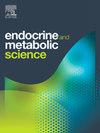The predictive value of the TG/HDL index for metabolic syndrome and its components: A cross-sectional study in the PERSIAN Guilan Cohort Population
Q3 Medicine
引用次数: 0
Abstract
Background
Metabolic syndrome (MetS) is a global health concern linked to cardiovascular disease and type 2 diabetes. The triglyceride-to-high-density lipoprotein cholesterol (TG/HDL-C) ratio has emerged as a promising biomarker for MetS due to its strong correlation with insulin resistance and atherogenic dyslipidemia. However, its utility in Middle Eastern populations, particularly in Iran, remains underexplored.
Objectives
This study aims to evaluate the association between the TG/HDL-C ratio and MetS in the Guilan Cohort Study (GCS), a population-based survey in northern Iran, and to identify sex-specific cutoff values for MetS prediction.
Methods
This cross-sectional analysis included 10,520 adults aged 35–70 from the GCS. Data were collected through structured questionnaires, anthropometric measurements, and biochemical studies. MetS was defined using NCEP ATP-III criteria. Receiver operating characteristic (ROC) curves were used to assess the predictive performance of the TG/HDL-C ratio, and logistic regression models were employed to examine its association with MetS, adjusting for confounders such as age, gender, BMI, and lifestyle factors.
Result
The overall prevalence of MetS was 41.8 %, with significant gender disparities (56.3 % in women vs. 25.0 % in men). Central obesity (58.0 %) and dyslipidemia were highly prevalent, particularly among women. The TG/HDL-C ratio demonstrated strong predictive power for MetS, with AUC values of 0.828 for men and 0.832 for women. Sex-specific optimal cutoffs were identified at 3.42 (men) and 2.80 (women), with high sensitivity (83.6 % and 72.2 %) and specificity (69.0 % and 80.9 %). Logistic regression revealed a significant association between the TG/HDL-C ratio and MetS risk, with adjusted odds ratios of 1.49 (men) and 3.02 (women) per unit increase.
Conclusion
The TG/HDL-C ratio is a robust and cost-effective biomarker for predicting MetS, particularly in resource-limited settings. The study highlights significant gender disparities in MetS prevalence and risk factors, underscoring the need for gender-tailored interventions. These findings support the integration of the TG/HDL-C ratio into routine clinical practice for early detection and management of MetS. Future research should focus on longitudinal studies and multiethnic validation to further establish the ratio's applicability across diverse populations.
TG/HDL指数对代谢综合征及其组成部分的预测价值:波斯桂兰队列人群的横断面研究
代谢综合征(MetS)是与心血管疾病和2型糖尿病相关的全球性健康问题。甘油三酯与高密度脂蛋白胆固醇(TG/HDL-C)比值由于与胰岛素抵抗和动脉粥样硬化性血脂异常密切相关,已成为一种有前景的MetS生物标志物。然而,它在中东人口中的效用,特别是在伊朗,仍未得到充分开发。本研究旨在评估Guilan队列研究(GCS)中TG/HDL-C比值与MetS之间的关系,GCS是伊朗北部一项基于人群的调查,并确定性别特异性的MetS预测临界值。方法横断面分析包括来自GCS的10520名35-70岁的成年人。数据通过结构化问卷调查、人体测量和生化研究收集。MetS采用NCEP ATP-III标准定义。受试者工作特征(ROC)曲线用于评估TG/HDL-C比值的预测性能,并采用逻辑回归模型来检查其与MetS的关系,调整混杂因素如年龄、性别、BMI和生活方式因素。结果met的总体患病率为41.8%,性别差异显著(女性56.3%,男性25.0%)。中心性肥胖(58.0%)和血脂异常非常普遍,尤其是在女性中。TG/HDL-C比值对MetS具有很强的预测能力,男性的AUC值为0.828,女性为0.832。性别特异性最佳截止值分别为3.42(男性)和2.80(女性),具有较高的灵敏度(83.6%和72.2%)和特异性(69.0%和80.9%)。Logistic回归显示TG/HDL-C比值与met风险之间存在显著关联,校正比值比为每单位增加1.49(男性)和3.02(女性)。结论TG/HDL-C比值是预测MetS的可靠且具有成本效益的生物标志物,特别是在资源有限的环境中。该研究强调了MetS患病率和风险因素的显著性别差异,强调了针对性别的干预措施的必要性。这些发现支持将TG/HDL-C比值纳入met早期检测和管理的常规临床实践。未来的研究应侧重于纵向研究和多民族验证,以进一步建立该比率在不同人群中的适用性。
本文章由计算机程序翻译,如有差异,请以英文原文为准。
求助全文
约1分钟内获得全文
求助全文
来源期刊

Endocrine and Metabolic Science
Medicine-Endocrinology, Diabetes and Metabolism
CiteScore
2.80
自引率
0.00%
发文量
4
审稿时长
84 days
 求助内容:
求助内容: 应助结果提醒方式:
应助结果提醒方式:


